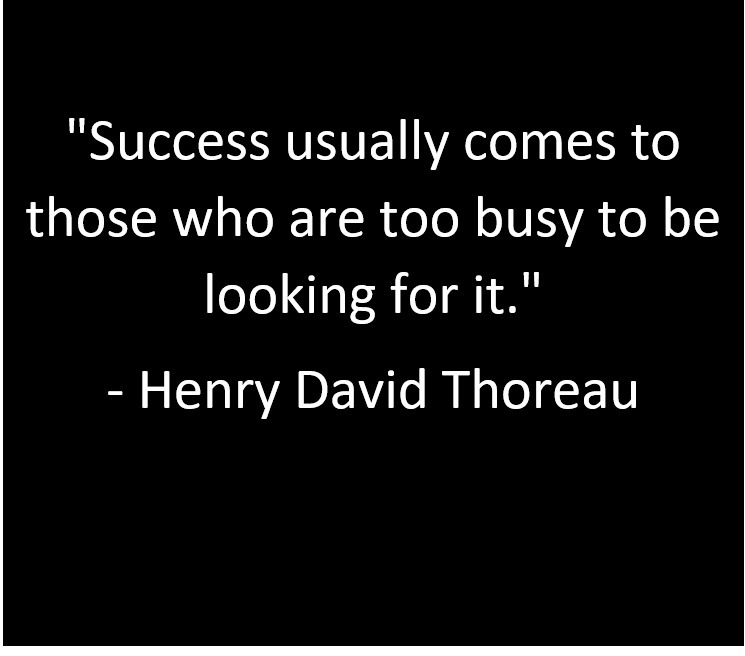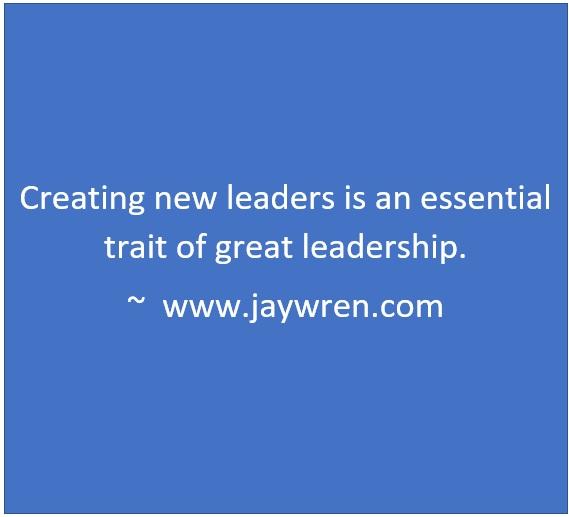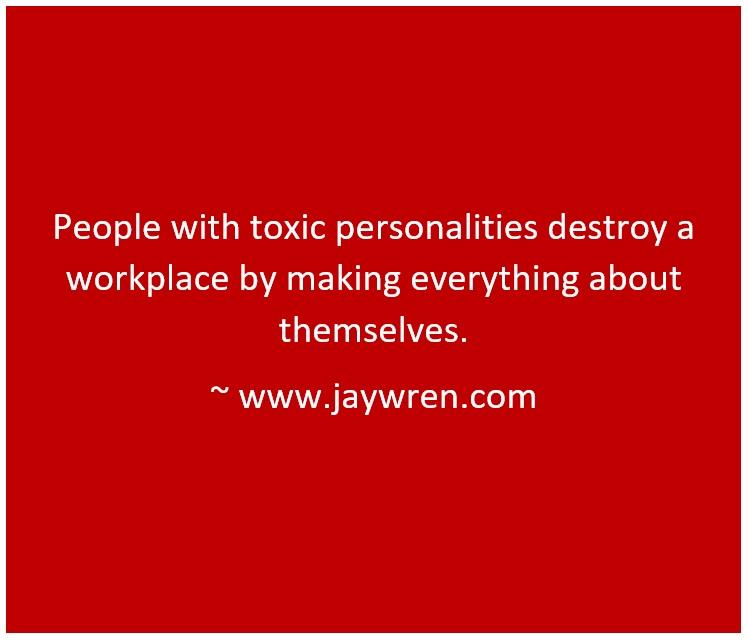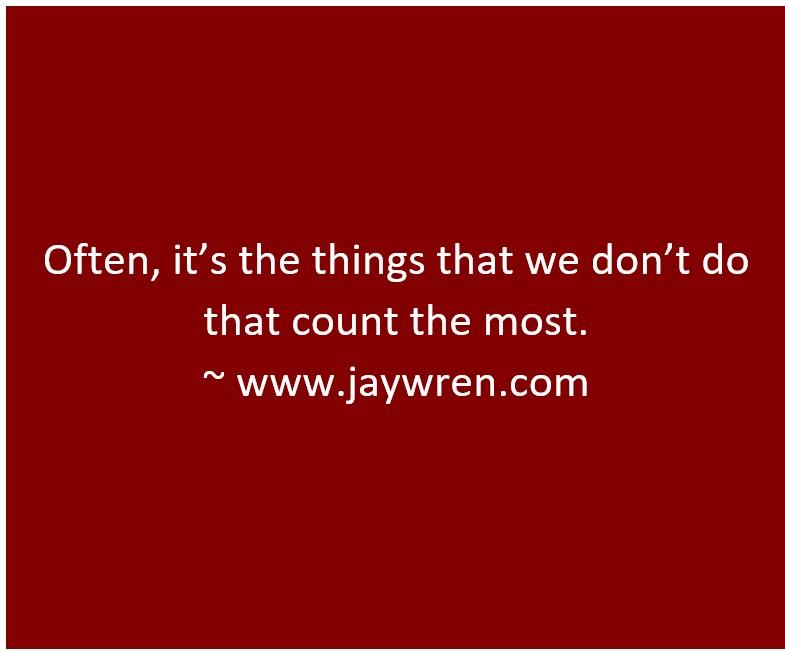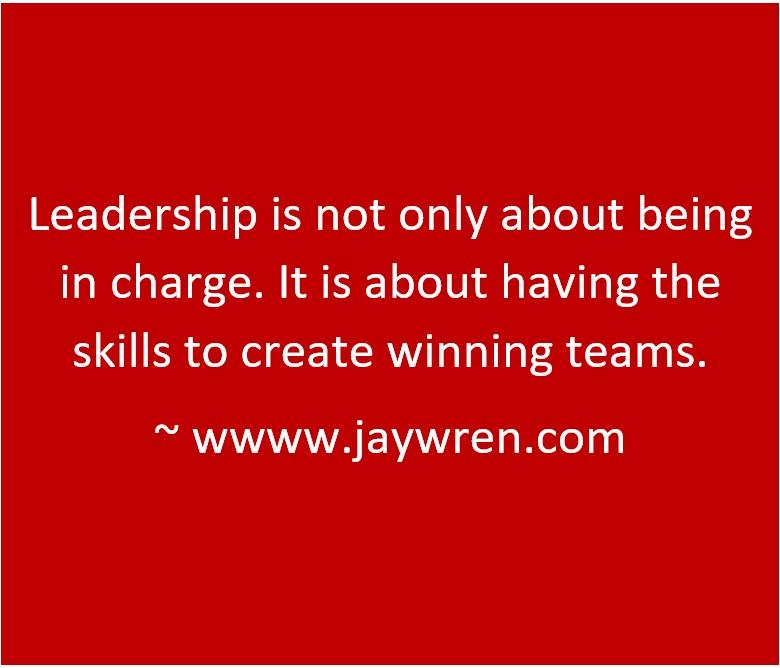Category: Leadership
The leadership category on Jay Wren’s website (jaywren.com) focuses on practical insights and strategies for effective leadership, particularly within a corporate or organizational context. It emphasizes the development of “authentic leaders” who prioritize self-awareness, honesty, and humility, fostering trust and success.
Key themes within this category include:
Authentic Leadership: Building trust through self-awareness, honesty, and humility.
Leadership Development: Providing actionable steps for companies to hire, train, and grow leaders, including principles of responsibility, authority, and accountability.
Creating Future Leaders: Highlighting the importance of internal leadership development for long-term growth, morale, loyalty, and engagement.
Measurable Success: Emphasizing that effective leadership is not just a concept but can be measured by results, with a focus on proactive training and mentorship.
In essence, Jay Wren’s leadership category offers guidance for individuals and organizations seeking to cultivate strong, ethical, and effective leaders who contribute to overall success.
Leadership Development: A Four-Step Process for Success
Leadership Development: How can companies hire and train people to become leaders? Here are four steps to effective leadership development.
Companies that produce great leaders become greater companies. ~ www.jaywren.com
Leadership Development — Four Steps
Creating future leaders is critical to the long-term growth of a company. An element in succession planning, creating leaders from within increases moral, loyalty, and engagement. Here are four elements to leadership development.
- Hire for Leadership
- Teach Responsibility, Authority, and Accountability
- Continual Training for Leadership
- Increase Responsibility
Hire for Leadership
People in any organizations have specific levels of responsibility. Some of those people will stay in the same job for their entire time with the company.
Other people come into a company as developmental candidates. These people may start in entry-level jobs. However, the company has a plan to move these people into bigger roles. Their responsibilities increase as they master each job.
Teach Responsibility, Authority, and Accountability
For new leaders to become successful, they must know their responsibility, their authority, and their accountability.
Responsibility defines the tasks and activities under a leader’s management. Authority is the power to make decisions and the power to hold team members accountable. Accountability in leadership development creates an understanding of expectations of performance.
Additionally, leaders must use these elements to teach their team members what the leader expects of them. Leaders can use these elements as reminders for team members to stay on task.
Train for Leadership
Leadership is not a mere concept. Companies can measure the success of their leaders based on results. The best companies don’t wait to have a leader fail. These companies have experienced leaders who can teach new leaders how to succeed. An ounce of foresight is worth a pound of hindsight.
These leaders must develop styles and practices that make their team as effective as possible. Training, hands-on management, greater feedback, asking questions that provide useful information are some of the methods companies can teach new leaders.
Increase Responsibility
For leaders to continue to grow, their responsibility must increase. Companies promote new leaders into bigger positions. These positions have a higher pay grade. Additionally, they have the greater responsibility.
However, companies cannot always promote leaders. But they must keep the leaders growing and engaged.
What companies can do is relieve experienced future leaders of bottom rung responsibilities. At the same time, companies can give them responsibilities that will prepare them for greater responsibility.
Creating Leaders: 4 Elements of Leadership Development
Creating Leaders: How can companies hire and train people to become leaders? Here are four steps to effective leadership development.
Companies that produce great leaders become greater companies. ~ www.jaywren.com
Creating Leaders — Four Steps
Creating future leaders is critical to the long-term growth of a company. An element in succession planning, creating leaders from within increases moral, loyalty, and engagement. Here are four elements to leadership development.
- Hire for Leadership
- Teach Responsibility, Authority, and Accountability
- Continual Training for Leadership
- Increase Responsibility
Hire for Leadership
People in any organizations have specific levels of responsibility. Some of those people will stay in the same job for their entire time with the company.
Other people come into a company as developmental candidates. These people may start in entry-level jobs. However, the company has a plan to move these people into bigger roles. Their responsibilities increase as they master each job.
Teach Responsibility, Authority, and Accountability
For new leaders to become successful, they must know their responsibility, their accountability, and their authority. Responsibility defines the tasks and activities under a leader’s management. Accountability creates an understanding of what to expect for failing to manage responsibilities. Authority is the power to make decisions and the power to hold team members accountable. Last, a leader must know the limits of their authority. They must know when to ask for direction from the people for whom they work.
Additionally, leaders must use these elements to teach their team members what the leader expects of them. Leaders can use these elements as reminders for team members to stay on task and meet the leader’s expectations.
Train for Leadership
Most of the articles that I read on types of leaders do not mention how much the conditions in an organization affect the leadership role and style. In an ideal situation, leaders have the authority to hire the best people. They can put people on their team who only need to know the objectives to perform successfully. In this case, leaders have more freedom to use the leadership style that prefer. They can be the coach, the servant leader, the hands-off leader, the strategist, etc.
In less than ideal situation, leaders have must operate with the circumstances they inherit. For example, a leader may have no control over which people get assigned to their team. These leaders may have to deal people in positions for which the people are not qualified. Additionally, leaders may have to work under strict guidelines that limit the leader’s authority to make decisions and direct their teams. In worst case scenario, some leaders must rely on other departments for support. And, some support departments just don’t support the teams they serve.
However, the leader is still accountable for managing their team for success. These leaders must develop styles and practices that make their team as effective as possible. Training, hands-on management, greater feedback, asking questions that provide useful information for the team member and the manager: these are some of the things a manager can do to make the team as effective as possible.
Increase Responsibility
For leaders to continue to grow, their responsibility must increase. Companies promote new leaders into bigger positions. These positions have a higher pay grade. Additionally, they have the greater responsibility.
However, companies cannot always promote leaders. But they must keep the leaders growing and engaged.
What companies can do is relieve experienced future leaders of bottom rung responsibilities. At the same time, companies can give them responsibilities that will prepare them for greater responsibility.
Toxic Personalities: A Poison in the Workplace
Toxic personalities create stress that spreads throughout an organization. What are the skills that you can develop to survive and even change toxic people?
Know What You Can Control
If you have the authority to act on the people with toxic personalities, it is your responsibility to change the behavior of these people or remove them from the workplace.
If you do not have authority over these people, there are steps you can take to steel yourself and even change their behavior.
Additionally, if you can in no way change the conditions of working with toxic personalities, you might consider changing jobs. Dealing with the daily stress of working with difficult people is painful in ways that can affect your mental and physical health.
Anger
Acting out of anger can just make the problem worse. The person with the toxic personality can become offended and defensive. They see you (your actions or personality) as the problem in the relationship.
On the other hand, you must prepare to be firm. I have dealt successfully with toxic behavior by confronting a person with the facts and consequences of their actions. However, changing a person’s personality is difficult. The process takes more than showing the facts of their behavior. Personality change, especially with toxic personalities, takes a commitment from the person with the problem
Skills for Surviving or Even Growing around Toxic Personalities.
Toxic people: When you can’t fight them, don’t join them. However, make yourself healthier.
When I can’t change the behavior of toxic people or avoid these people altogether, I focus on the changes I can make in myself to become a healthier person.
Here are some things that work for me.
1. I write about my feelings.
When I write about my feelings, I cut the sting of painful emotions.
In writing about my emotions, I name my feelings. Fear, anger anxiety, insecurity, and resentment are common feelings that people have around toxic people. You may have other bad feelings. When I experience these feelings, I write about them.
2. I write about my actions.
In this step, I can see what things I can change in my own behavior to reduce the damage in a toxic relationship. For example, if I act out of anger, I can change my actions.
3. I discuss what I am feeling with a mentor.
One of the problems with writing about my feelings is that I have trouble seeing solutions. Instead I focus on how people have harmed me.
However, I have close friends I can trust. These people keep what I tell them a secret. These friends are mentors who show me how I can grow and improve my behavior.
4. Avoid the Poison: When I can’t change the behavior of toxic people, I avoid them. If there is no reason to have to deal with them, I don’t.
Habits: Giving Up the Behavior that Weakens Our Careers
Habits: The things we don’t do are as important as the things we do to be a winner in the workplace. Here are eight things to avoid as you work to build a successful career and become a leader among your peers.
Often, it’s the things that we don’t do that count the most. ~ www.jaywren.com
The Pitfalls to Winning Behavior
Some of the pitfalls to winning behavior are habits that seem normal, but annoy others and detract from our accomplishments. I have been guilty of some of the things I am going to discuss. Seeing the harm of these habits has helped me become more engaged with other people and more mindful of their needs and interests. In ways that I can’t measure, avoiding these behaviors has help me build relationships and increase my professional network.
1. Using Long, Uncommon Words
Building your vocabulary is a good practice. However, using big words to try to sound intelligent and impress people is phony and annoying. Furthermore, using long or uncommon words confuses people and detracts from your point.
It is narcissistic to throw around words that few people know or that people know as pretentious. You become like a person who poses in front of the mirror in a public restroom.
As a lesson about my own use of words that meant little but I used to impress others, my Mother once said to me, “You are so bombastic and I am so illiterate that you will have to elucidate for me to comprehend.” Lesson delivered; lesson learned.
2. Using Facilities and Parking for the Handicapped
People who need handicapped facilities have no choice. They need them when they need them.
Abusing the use of handicapped parking is not only annoying, it is illegal. Most states have stiff fines for using handicapped parking without legal authorization. Furthermore, most people have no tolerance for people who abuse the use of handicapped parking.
Restroom facilities become more challenging, because some locations only have one or stalls. I have been in a one-stall restroom when a person in a wheelchair was waiting in line. The situation was awkward even though I had no choice. The best practice is, whenever possible, to defer to people who might need the handicapped facility.
3. Yacking on Your Cell Phone
There is something odd about strangers carrying on a conversation on a cell phone when they are next to you.
They have entered your space and are holding a conversation that doesn’t involve you.
I have been guilty of using a cell phone in a supermarket. As my wife gave me instructions on the things that she wanted me to buy, I passed one shopper three times. The third time he suggested that I stop walking around talking on my phone and make a list.
This was an awakening to me just how easily cell conversations annoy the people around us.
Around the office, it is good to be aware when you are carrying on cell phone conversations around people who aren’t involved in the discussion.
4. In Meetings, Act Like You Belong
Texting and sending emails on a phone at the wrong time can be just as annoying.
At work, you can quickly annoy people, including people you need to impress. Look at the situation. You are in a meeting, and everyone is discussing the topic of the meeting. Your mind wanders from the discussion, and you suddenly feel the urge to send a message or read your email.
You mind tells you that you must deal with your priorities. However, you are creating a distraction for everyone in the room. People who are in a meeting are mentally like members in a marching band. They are in coordination. When you start texting or sending emails, you break step and become a distraction.
5. Habits of Blocking the Exits
Blocking the exits or any other passageway is annoying. Some people do not know how to navigate blocked hallways or aisles. Other people feel awkward asking to get past.
People often gather at the entrance to meetings or at the door when leaving. If this is a problem in your office, I recommend that the senior person in the room ask people not to block the door when they are leaving.
On the other hand, if you do need to get past people in a blocked passageway, simply say, “Pardon me.
6. Constant Complaining
Negative information creates bad moods. A constant flow of negative information destroys morale and increases turnover.
Everyone has problems. Solving those problems makes you look like a leader. Whining about those problems not only is annoying. It soon makes you look incompetent.
Instead of complaining, especially constant complaining, focus on solutions.
7. Self-Reference
Receiving credit for your work is a crucial step in the path to success. However, constantly talking about yourself is annoying and makes people see you as shallow.
If you are not receiving credit for the work you are doing. talk with your managers. Having them reference your accomplishments is far more effective than when you are doing it. Furthermore, avoiding this behavior has helped me build a strong network.
Additionally, give credit to other people for their accomplishments. People not only enjoy receiving credit. They often remember the people who helped them receive credit. This type of winning behavior will help you build a powerful network.
8. Habits – Trying to Be Funny
I remember an article that helped me know that not everyone understands the impact of their failed attempts at humor. The author started his article with religious jokes. These jokes were off topic.
The jokes weren’t clever. They were flippant. Furthermore, they distracted from the point of the article.
The author was undermining his own work, by not practicing winning behavior.
Leadership Skills: 7 Steps to Creating Powerful Teams
Leadership Skills: 7 Steps to Creating Powerful Teams. Ways to interact with teams to create engagement and understanding.
Smart Leaders Share Their Ideas with Others
It takes time and patience to share ideas and train team members. Leaders who invest this time to show team members shortcuts and special skills increase the success of the individual members of the team and the success of the entire team. Moreover, these members become more engaged as they implement the new ideas that smart leaders have taught them. Working on these leadership skills empower leaders to connect with their teams in meaningful ways.
Leadership Skills to Delegate Responsibility
Caught in the daily cycle of handling routine responsibilities, managers can procrastinate working with team members to take on additional responsibility. However, as team members take on new responsibility, they increase their abilities to take on greater roles. Delegating authority is the first step in succession planning and in increasing employee value. Not just having responsibility, but taking responsibility for the success of a project creates instant engagement.
To delegate responsibility requires the leadership skills for working with and trusting employees.
Develop Leadership Skills to Become a Big Picture Person
Good leaders know that a minor slight or small loss today often has no significance in the big picture. These leaders can respond from a point of view that their employees are assets. Keeping perspective with a view of the long-term, leaders can see employee mistakes as opportunities to teach the people who work for them.
A case in point, I once became impatient with a secretary who was hesitant about helping me schedule a flight. When I pressed her on the matter, she confessed that she had never scheduled a flight. She had never been on an airplane. The fact was awkward for her. She was so bright and capable in so many ways. I apologized for my impatience. I explained the simple process to her. She booked the flights. A little bit of patience from me helped us both move on to the important things we needed to do that day and to helping her develop a new skill.
Each new skill enables employees to do more and opens the door to engagement. Using leadership skills, for me, was not always automatic.
Leaders Can Improve Their Communication Skills
Everyone can work on this basic skill every day. For me, the single best way to improve this skill is to become a sponge and not a waterspout. I can read more than I write. I can listen more than I speak. When I read and listen to effective communicators, I reinforce good habits that make me a more effective communicator.
Additionally, I can add to my vocabulary by finding the definition of words that are new to me. Expanding my vocabulary is especially important today. New technologies require new words as well as a better understanding of words that writers use in a different way in different context.
For example, writers have used the word “protocol” about procedures governing state or diplomatic matters. With the emergence of computer networking, tech writers use the word to refer to rules regarding transferring data across an Intranet and the Internet.
The leadership skills for effective communications is the framework for being a successful leader.
Leadership Skills to Know How to Allow Others to Take Center Stage
Smart leaders can encourage others to take the lead. By increasing how often team members take center stage, these leaders can increase the confidence and skills of team members to take on greater responsibility and increase their value to the team.
Show concern for people who are struggling to move to center stage. Many wallflowers are quietly waiting to receive recognition. Giving them opportunities to take small steps to greater roles can turn wallflowers into leaders.
Giving Credit to other People is a Leadership Skill
Saying, “Thank you” is easy to do. People appreciate it when leaders say, “You did a good job.”
Additionally, it is important to recognize the correct person. When leaders give credit to team members for the work of others, the team suffers.
Leadership Skills: Walk the Talk
It is very easy for leaders to criticize people for their shortcomings. Likewise, it is easy for leaders to take the easy path of not rising to the standards they demand of their employees. and ignore my own. For the people around me to respect me, I can’t say one thing and do another. I must walk the talk.
